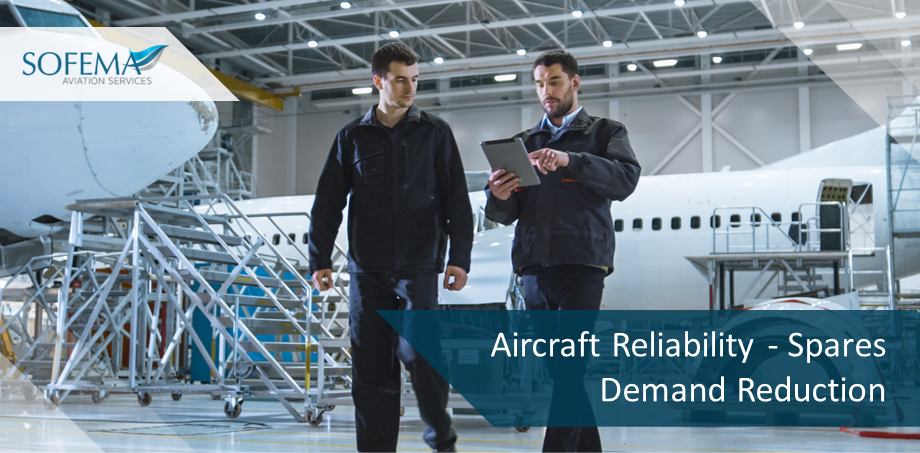Sofema Aviation Services (SAS) would like to thank Rustom Sutaria for providing his considerations regarding Aircraft Reliability as a tool to Reduce Spares Demand.
Utilising aircraft reliability to optimise maintenance programmes affected by spares procurement challenges – An alternative to the grounding of your aircraft.
A recently published article from Airline Business Weekly Briefing (“Aircraft maintenance delays threaten to become 2023 theme”), specifically cites the problem of spares availability and the potential for grounding aircraft that has prompted this opinion piece.
Discussions with our colleagues and business associates suggest that, with effective reliability and optimized maintenance programming, the “time-on-wing” for the vast majority of operators’ spares can be optimised, and, to a greater extent, pressures in terms of spares demand can be alleviated, with the potential for avoiding the grounding of aircraft.
Reliability not only demonstrates the effectiveness of the AMP but also provides valuable insights, that if (correctly) interpreted, can lead to the implementation of lower minimum inventory levels, that in turn reduce demand for spares, not least promote better short and medium-term spares planning in a challenging procurement environment.
The reader will of course realise that the intent of any reliability report, is not only to identify trends for unscheduled component removal but to also utilise this data to additionally identify where scheduled removals can benefit from escalation opportunities, thus allowing components to remain on-wing longer.
In this regard, operators need to consider whether they have missed a trick
Where hard-time components with mandatory removals for inspection or overhaul requirements are concerned, an effective reliability analysis can also be employed from the perspective of considering “Soft-time Overhaul” intervals which allow for hard-time components to remain on-wing for longer. However, there is a price to pay when employing this approach.
AMPs will have to be amended (and subsequently re-approved) with the addition of repetitive high-frequency inspection tasks that are designed to assess the airworthiness of the component with a view to a decision to remove. In other words, hard-time removal requirements align more with the approach required by on-condition or condition-monitored components and tasks.
The other point to make is that this approach does tend to limit itself to components that are hard-timed for removal, inspection and overhaul, rather than those components that are limited by hard-life, where removal and discard may be required.
The opportunity in terms of optimising time-on-wing predominantly exists with “on-condition” and “condition-monitored” components. This does mean that greater importance to the operator’s reliability programme (beyond AMP effectiveness) in terms of (near flawless) data, analysis and engineering judgement will be critical to escalation and soft-time strategies. However, safety-critical components will undoubtedly be subject to the requirements of ALIs, CMRs, CDCCLs, etc.
The whole point is, that utilisation of soft-time and escalation strategies, that are supported by effective reliability analysis and engineering judgement, may reduce minimum inventory requirements, and keep components “on-wing” for longer, whilst remaining compliant with the operator’s obligations to the type certificate.
Before you all go rushing off to see your maintenance and reliability programme managers, don’t forget, that all of this has to be acceptable not only to the regulatory authority where your aircraft is registered but also to the type certificate holders and their regulators. The last thing anybody wants is to jeopardize the Type Certificate and the Certificates of Airworthiness or your fleets.
Ultimately, these strategies can remove the need for operators to ground aircraft from their serviceable fleets, not least having wider and longer-term benefits in terms of maintaining operational scheduling, so long as airworthiness, regulatory and type certification issues are satisfactorily addressed.
In simpler language, effective and well-demonstrated component reliability performance (in this regard) means, longer time “on-wing” for the component, considerably reduced pressure for spares and increased availability of the aircraft to the operational schedule.
Sofema thanks Rustom Sutaria for providing this guest blog. Rustom is a Director at Avia Intelligence Ltd. and an experienced SAS instructor. You can contact him at rs@aviaintelligence.com.
Guest blogs are welcome at Sofema! We always provide attribution for the author. Submit your blog content at team@sassofia.com with the subject “Guest-Blog”.
Tags:
ALI, Guest blog, hard-time, Soft-time, Spares procurement, Certificates of Airworthiness, SAS Instructor, Aircraft components, Type Certificate, SAS blogs, Rustom Sutaria, Aircraft Inspection, Aircraft Reliability, Aircraft, CMR, CDCCL, Airworthiness, Sofema Aviation Services, EASA, Compliance, aviation safety, aviation, Approval, AMP, Aircraft Maintenance




